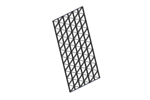Scheurer Swiss implements carbon fiber-reinforced 3D printing for bouncing space robot
Scheurer Swiss supports ETH Zurich in the development of a lightweight “hopping” robot for exploring asteroids.
SpaceHopper with fiber-reinforced 3D-printed electronic structure (triangular structure) and legs (in black). Photo Credit, all images: Scheurer Swiss, ETH Zurich
Engineering company, Scheurer Swiss GmbH (Volketswil, Switzerland), is supporting the Swiss Federal Institute of Technology’s (ETH Zurich) focus project, “SpaceHopper,” a three-legged hopping robot that is specifically designed for controlled locomotion in zero gravity and is expected to provide new opportunities for asteroid exploration. For the project, Scheurer Swiss is 3D printing carbon fiber-reinforced robot components and using its extensive network to connect the project team with other companies to complete it. After eight months of development, the first prototype was successfully presented at the end of May.
According to Scheurer Swiss, the weightless environment of small, astronomical bodies required a new research solution. With the support of experts from research, industry and lightweight construction, ten engineers from ETH Zurich and ZHAW were able to develop and build the lightweight, three-legged robot with a design optimized for low-gravity hopping.
“One of the challenges was to make the legs as thin-walled as possible to minimize the overall weight of the robot. Nevertheless, they have to withstand the forces of the bouncing impact,” mechanical designer, Emma Steinke, emphasizes, “We are glad to have Scheurer Swiss on our side as a lightweight design expert. The competent expertise around state-of-the-art fiber composite technologies and 3D printing as well as the large network of Scheurer Swiss were very valuable for us and contributed to the success of our focus project from the very beginning.”
Scheurer Swiss CEO, Dominik Scheurer, points out that carbon fiber-reinforced 3D printing is ideally suited for the robotic components because virtually any shape can be produced. “Hollow bodies, such as the robot’s legs, can be provided with support structures to stabilize them without weighing them down unnecessarily,” Scheurer notes. “Additive manufacturing [AM] is the ideal manufacturing process for this, and it’s very cost effective.”
Moreover, with AM, objects are manufactured directly on the basis of 3D computer data, or so-called rapid product development. In particular, components with a high degree of customization can be produced promptly and cost-effectively with the necessary stability and functionality. Scheurer, known for its lightweight construction, is certain: “3D printing is currently one of the most modern lightweight construction technologies and is shaping the future of the manufacturing industry like hardly any other process. The intention is clear: More flexibility, creativity and cost efficiency in product development.”
Related Content
-
High glass transition temperature, 100% bio-based thermoset resins for space composites
With the European Commission Restrictions Roadmap soon banning entire classes of chemical substances found in fossil fuel-based synthetic polymers, the space industry is looking to a chemical combination to produce competitive thermoset resins.
-
HyImpulse, Adamant Composites linerless CFRP tank passes hydrostatic burst test
The liquid oxygen (LOX) tank, to be used in a HyImpulse smallsat launch vehicle, demonstrates the ability to withstand pressures well beyond the limits of its intended use.
-
Rocket Lab begins installation of large AFP machine for rocket production
The 99-ton AFP machine, custom-designed and built by Electroimpact, is claimed to be the largest of its kind, expecting to save around 150,000 manufacturing hours in the Neutron rocket’s production process.


















